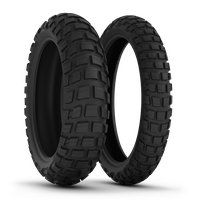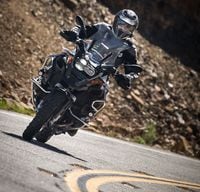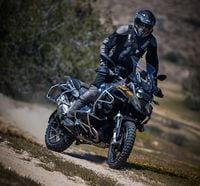When given a choice of rubber, it seems like most ADV riders looking for true off-road performance reach for Continental’s venerable TKC 80 Twinduro tire. Michelin even said so in its presentation to the media introducing this new Anakee Wild adventure knobby, calling Conti’s TKC 80 the “benchmark” in the category. The TKC 80 has not been without competition, with Metzeler, Hidenau, and Mitas (to name a few) offering competitive ADV rubber. With the Anakee Wild—a so-called 50/50 tire, meant for half road, half off road—Michelin aimed directly at the top and intends to prove that the latest Anakee is more than a match for the TKC 80.
The Road Ride
Since Michelin's event was local to our SoCal offices, I chose a BMW R1200GS Adventure testbike in our garage for a test mule, and had set out that morning for the start point of the ride with a fresh set of Anakee Wilds mounted. First up was about 100 miles across greater Los Angeles on the freeway, in the midst of rush hour. Perfect break in for knobbies. I experimented with panic stops to make sure the Wilds would have me covered in the likely event of a text-induced brake check, and I was impressed with traction.
The only other notable item is that these Anakee Wilds are loud at freeway speeds, even for knobbies. (Later, the a Michelin engineer would explain, through a heavy French accent, that knobby tires are just plain loud on pavement and nothing can be done about it.) In any case, ADV riders are used to loud tires, and over the course of the day I found that the Wilds seem the loudest between 45 and 60 mph—above that, the wind blast drowns out some of the road noise.
On the first stint of the ride, the group ascended the famous southern stretch of California Route 33—a lovely road, no matter what you’re riding. It’s not exactly knobby territory, but the Wilds did well. There’s plenty of grip to carve through corners and enjoy the road, and I was impressed how little the Wilds seemed to flex (considering it’s a radial construction, and a fully fueled R1200GS-A is nearly 600 pounds before adding a rider).
The handling characteristic is odd, though. A very round profile means the bike falls into the corner really easily; almost too easily. In order to hold the GS on line I had to steer the bike into the corner with quite a bit of pressure on the handlebar. As experienced riders know, a good road tire will fall into a corner but be neutral when leaned over—this makes feedback from the tire easier to read and buoys confidence. The Anakee Wild doesn’t have that feel, but to be fair most knobby ADV tires feel this way. Even Continental’s TKC 80, which has good road grip, definitely feels weird at first and you have to learn to trust it. The Anakee Wild is comparable, but it feels slightly more severe and for some reason I never came around and truly trusted the tire, even though it never broke traction.
Part of the reason my confidence didn’t swell could have to do with the claims that the Anakee Wild will outlast the TKC 80 by a factor of two or three. Michelin assured us that even after 6,000-mile test rides the Wild still had tread left to spare (TKC 80s often wear out around 3,000 miles). If that’s true, then the compound is likely much harder than the rubber used on, say, a TKC 80 or a Metzeler Karoo 2. Harder rubber lasts longer, but sometimes sacrifices feedback and peak traction. That’s my theory.
The Off-Road Ride
In the afternoon, Michelin basically turned the group loose in an Off-Highway Vehicle park and let us experiment with the Anakee Wild in the dirt. And even though Michelin says this tire is a 50/50 compromise between street and dirt, it is clearly aimed at customers who want off-road performance. The OHV park offered plenty of hill climbs, steep descents, and otherwise sandy, rocky, terrain. This is not always the easiest place to ride an R1200GS Adventure, but I switched off the traction control and ABS and asked the tires to impress me.
A big ADV bike like the GS is especially heavy on the front tire, and a good test of an off-road tire for this bike is how well the front end works. I found front grip to be acceptable, and most importantly quite forgiving—I lost the front in gravelly sections on a few occasions, but it always came back. Rear grip is a lot easier (and more fun) to explore, especially in dry terrain. The Anakee Wild-shod GS made quick work of all climbs I attempted in the OHV area, scurrying over exposed rock, loose gravel, and sand alike.
So the overall design of the tire seems to work well, though I can’t say the Anakee Wild showed me anything in the dirt that the competition could not achieve. Left to my own off-road devices I still think the TKC 80 would go on my bike for challenging adventure terrain. Lastly, I should say I didn’t play with pressure. Gritty ADV riders will surely air down their tires for maximum grip, but since Michelin doesn’t “recommend” doing that, I rode with pressures in the mid-30s in both tires. (What Michelin recommends, incidentally, is manufacturer pressures—in this case 36 front and 42 rear—but I couldn’t bring myself to put that much air in.)
The Upshot
Michelin mentioned on a few occasions the reasons it chose radial construction, most importantly that it allows the performance of the sidewall to be separated from the performance of the crown of the tire. Truth be told, I can't say the radial construction was very noticeable. Continental's TKC 80 is a bias-ply tire, while Metzeler's Karoo 2 is also radial, and I think all three tires (including the Wild) are comparable as far as grip and flex. Michelin clearly took a hard look at the category before designing and launching the Anakee Wild, and I think this new ADV rubber can be considered a viable competitor in the category.
Is it a clear winner? We’re still waiting on the official MSRP of the Anakee Wild, but the internet is already offering them at around $400 per set for a full-size ADV bike. That’s pricier than you can source TKC 80s, but it’s also a newer tire. At any rate, longevity will be the real test. If the Anakee Wild really does last 6,000 or even 8,000 miles it will have a clear advantage over some of the competition. If not, I don’t think the Wild has a clear hook to entice riders. It’s a bold step for Michelin to take into a very competitive category, full of educated and experienced consumers. Even with admirable pavement grip and stability, decent off-road chops, and longer life, I’m not sure it will take the place of the TKC 80 as the go-to choice for ADV riders. Time, and the market, will tell!










/cloudfront-us-east-1.images.arcpublishing.com/octane/GYUU7DK2PV5IOCYEFNWDHXRQEY.jpg)




/cloudfront-us-east-1.images.arcpublishing.com/octane/S35YGSEMEZB4BLTDJTSZPF4GLA.jpg)
/cloudfront-us-east-1.images.arcpublishing.com/octane/5UOT6HPX2JFMRJAX6EH45AR4MQ.jpg)
/cloudfront-us-east-1.images.arcpublishing.com/octane/OKWOJWAKP5EP3OACCRRWPCIX2Q.jpg)
/cloudfront-us-east-1.images.arcpublishing.com/octane/2WF3SCE3NFBQXLDNJM7KMXA45E.jpg)
/cloudfront-us-east-1.images.arcpublishing.com/octane/G4MG6OUCJNBSHIS2MVVOTPX65E.jpg)
/cloudfront-us-east-1.images.arcpublishing.com/octane/IIGGWFOTOJGB7DB6DGBXCCMTDY.jpg)
/cloudfront-us-east-1.images.arcpublishing.com/octane/QSTCM6AVEZA5JJBUXNIQ3DSOF4.jpg)
/cloudfront-us-east-1.images.arcpublishing.com/octane/U4I7G625B5DMLF2DVIJDFZVV6M.jpg)
/cloudfront-us-east-1.images.arcpublishing.com/octane/B6XD6LS6IVCQPIU6HXDJSM3FHY.jpg)
/cloudfront-us-east-1.images.arcpublishing.com/octane/ICL63FEDDRDTTMINYICCEYGMDA.jpg)
/cloudfront-us-east-1.images.arcpublishing.com/octane/FCGZHQXRBZFLBAPC5SDIQLVF4I.jpg)
/cloudfront-us-east-1.images.arcpublishing.com/octane/WNOB6LDOIFFHJKPSVIWDYUGOPM.jpg)

/cloudfront-us-east-1.images.arcpublishing.com/octane/X33NU3E525ECRHXLNUJN2FTRKI.jpg)
/cloudfront-us-east-1.images.arcpublishing.com/octane/6KKT5NNL2JAVBOXMZYS5ZO76YA.jpg)
/cloudfront-us-east-1.images.arcpublishing.com/octane/J5RKG5O455GMPGQRF2OG6LRT7A.jpg)
/cloudfront-us-east-1.images.arcpublishing.com/octane/GX2CIZKQVRH2TATDM26KFG2DAE.jpg)
/cloudfront-us-east-1.images.arcpublishing.com/octane/ZWIDYSAKQZHD5BHREMQILXJCGM.jpg)
/cloudfront-us-east-1.images.arcpublishing.com/octane/CYUHJZCTSJCH3MRAQEIKXK7SCQ.jpg)
/cloudfront-us-east-1.images.arcpublishing.com/octane/LKOFINY56FCXJCANJ5M7ZDQUBY.jpg)
/cloudfront-us-east-1.images.arcpublishing.com/octane/4NBPDACMWJH63JQYJVK3QRBDZI.jpg)
/cloudfront-us-east-1.images.arcpublishing.com/octane/KKHQHRR3FJGX7H2IPU6RALMWG4.jpg)

/cloudfront-us-east-1.images.arcpublishing.com/octane/5IOFS5JAE5FOXMNA23ZRAVVYUU.jpg)